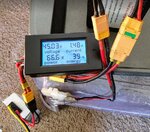harryS
Well-Known Member
I have a 48V battery made up with Samsung 30Q cells, purchased in August of 2015. These cells are rated at 3AH, so the battery would be 12AH, so that's about 500 useable watt-hr (576 wh in theory).
Coming up on 22 months, it pumps out half that power, about 220 watt-hr and it's down to 45 volts. I probably helped beat this battery to death. First year I had it, I kept it charged when it wasn't being used much. Bad for lithium ions.
Well, it's still good for about 20 miles.
Coming up on 22 months, it pumps out half that power, about 220 watt-hr and it's down to 45 volts. I probably helped beat this battery to death. First year I had it, I kept it charged when it wasn't being used much. Bad for lithium ions.
Well, it's still good for about 20 miles.
